Is this the best osprey nest ever? This is from Cornell's Celebrate Urban Birds, you can see more here.
Unexpected Chukars
I had a meeting with my friend Mark Martell at Minnesota Audubon yesterday. When I pulled into the parking lot I saw a bunch of small, round birds running in the parking lot. At first, I thought, "young pheasants?"

When I parked my car, I could see they were chukars...and rather friendly ones at that. I've seen chukars in Utah but this was the largest flock I have ever seen in Minnesota. Theses are most certainly released birds--they are native to Eurasia. Either there is a game farm nearby and they are escaping or someone is raising and releasing them.

I'm not really a fan of raising and releasing chukars--they are non native and therefore competing for food with native wildlife, they don't do well in Minnesota winters and really, all these chukars ever become are coyote and fox food...and maybe food for Cooper's hawks too.
Anyone else have chukars showing up to their feeders?
Autumn Bobolinks
I woke up in the dark on Sunday morning and was irritated. I realized that I was awake and since it was still dark out, I assumed it must have been in the middle of the night. Was it the humidity? Was it the moon? Was it that early evening cup of coffee? All three could be causes of insomnia for me. Since sleep wasn't coming, I decided to get up and do some writing (Non Birding Bill calls this my acorn gathering time, I generally say yes to a TON of freelance projects in the late summer to tide over the leaner months in winter). I walked into the living room and was surprised to see the clock read 5:30 am. Waking up at that time would make sense since I went to bed early the night before...CRAP, it's dark at 5:30am--that means the days are getting seriously shorter. I said, "Screw writing." Then grabbed my digiscoping equipment and hit the road. Gotta enjoy the warm weather and birds while it lasts.
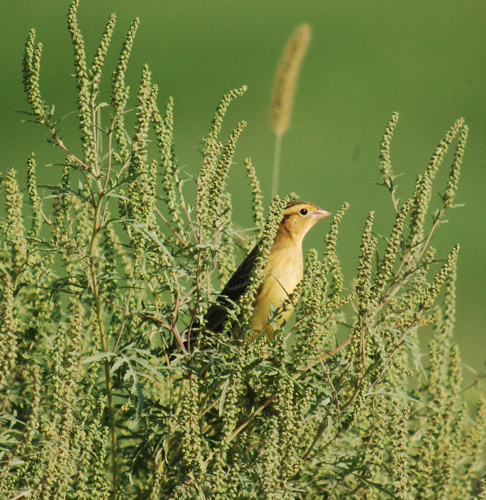
I took in a ton of fall migrants, but my favorite birds were the flocks of bobolinks nibbling on grasses along some gravel roads. I pulled over and was serenaded by late summer katydids while took photos of the yellow birds as they popped out and then down in the tall grasses. I'm not sure if this is a male or female, this is the bobolink's non breeding plumage and they both look the same. If you click on this link you can see what a male bobolink looks like during the breeding season--quite a dramatic change!
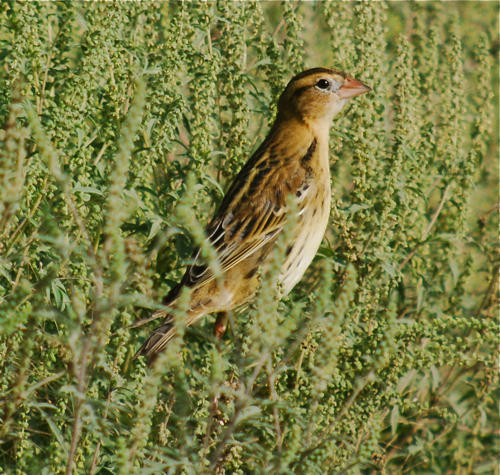
I sometimes have trouble remembering that bobolinks are thought to be in the blackbird family--especially in the fall. They look like large yellowish sparrows.
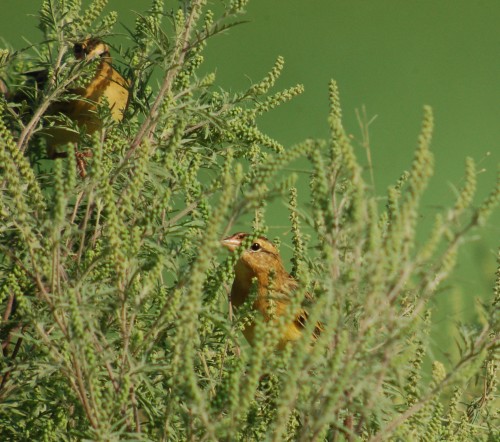
This is my favorite photo--the bobolinks lurking and hiding while feeding. The plumage makes sense while migrating. These birds will also have to contend with the millions of raptors moving south this fall too. They yellow and brown stripes will help them hide while they feed.
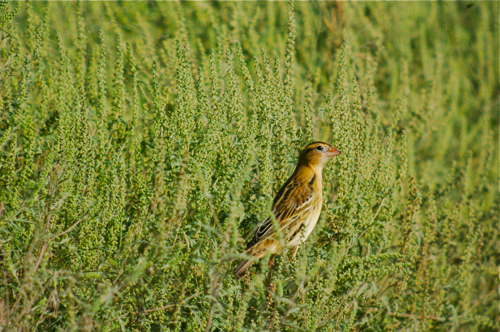
These bobolinks were near some flooded farm fields with lots of shorebirds, I actually went shorebird watching a couple of times last week, but shorebird id stresses me out and I haven't put the photos up yet. I'll have to bite the bullet and get them up. Their migration is full on.
If you haven't been out to enjoy some birds, get out there now. Migration is on!
Wanna Help Finance Alex & Me Movie?
I got the following request in my inbox: We are reaching out to you for your help on our special project. It is our great pleasure to announce the launch of our brand new website aimed at including you and your fellow bloggers in the making of a real Hollywood motion picture!
Earthrise Pictures and FaR Out Productions have acquired the theatrical rights to Dr. Irene Pepperberg’s book “Alex & Me.” This New York Times best-seller is the heartwarming true story of the incredible bond between two special creatures--woman and bird--who over the course of 30 years opened an unprecedented window into the hidden world of avian intelligence.
In order to maintain a day-to-day commitment, we need the loving support and generosity from bird lovers everywhere. Writing a screenplay takes a tremendous amount of time and research to craft a story that is both accurate and entertaining.
Every donation made on the website will help us expand our lab space, offer video blogs & fun interactive games, and post updates with the latest news from Hollywood. It’s all through PayPal so the contribution is safe and secure.
Also, for a minimum donation of at least $20, the contributor will have their name in the credits of the film and full access to everything inside the Movie Lab.
This is a rare opportunity for the birding community. Alex and Irene’s story is one of a kind, and we owe it to them for all their hard work and amazing accomplishments. This is indeed a story for the big screen.
Beehives Attract Flycatchers
 This is an interesting little bird. It's an eastern wood-peewee that was singing out around Mr. Neil's property. Periodically, the peewee would flip out from its perch and grab some insects. I didn't get a photo of it, but as I was watching the peewee through the scope, I noticed it grabbed a bee! That's when I realized this peewee was perched right over our yard hive and is hanging out in what we call the "bee highway" or the main flight path bees follow going to and from the hive.
This is an interesting little bird. It's an eastern wood-peewee that was singing out around Mr. Neil's property. Periodically, the peewee would flip out from its perch and grab some insects. I didn't get a photo of it, but as I was watching the peewee through the scope, I noticed it grabbed a bee! That's when I realized this peewee was perched right over our yard hive and is hanging out in what we call the "bee highway" or the main flight path bees follow going to and from the hive.
This is not the first flycatcher I've seen around the hives. Great-crested flycatchers show interest as well. I'm not too worried about it, there are several thousand bees, so a dozen or so eaten by birds is manageable. Plus, I suspect the birds prefer drones--they are bigger, fatter, juicier, slower and being males, they do not sting.
Bee Sounds
I thought I would share some sounds of our bees. We're down from 8 eight hives from the beginning of spring to six. One of the new hives failed (something happened with the queen) and the red hive...well she swarmed and no new queen hatched afterwards. We combined her remnants with another hive so her workers had a shot at life in another hive. While we were doing all of this, I took the opportunity to record some sounds of a hive. Below is a healthy, strong, two year old colony. Note the buzzing is in unison. You will hear a nearby individual bee because she is close to the microphone, but you can hear how her buzzing fits in with the over all din of the hive. You'll also hear a second individual buzz--that's from a bee landing. This sound was taken after we had done a minor inspection, so the girls were a little bit on edge.
[youtube]http://www.youtube.com/watch?v=a_dHJjMT2BE[/youtube]
Now, here is the sound of a queenless colony (you'll also hear Mr. Neil explaining some bee technique to a guest in the background). But note in this video that the buzzing is all over the place, it's not cohesive, it's not in unison. It's a quieter hive and you make out almost all individual bees. The buzzing is dissonant and in some cases the buzzing almost cries out like a question: what am I supposed to be doing?
[youtube]http://www.youtube.com/watch?v=cN8O4_PxOsA&feature=channel[/youtube]
Bees have duties according to their ages. When they first hatch, they are nurse bees--tending larvae, maintaining pupating cells, feeding the young. As they get older, they more on to construction and eventually become foragers who look for pollen and nectar. Without a queen with a strong pheromone to hold them to hive there is no larvae to tend. Some workers will suddenly develop ovaries and try to lay eggs (which end up as deformed drones) since there is no larvae to tend too. The hive is in chaos and disarray. I think you can hear that in a queenless hive by the sad dissonant buzzing.
But then there is my favorite sound: the quiet of a new hive. Below is one of the hives we installed this year. As we do a quick inspection, the bees on this roof are buzzing quietly and contentedly. They also seem more curious about what you are doing to the abode, rather than defensive. Their buzzing is so quiet, you can barely hear it:
http://www.youtube.com/watch?v=sNKNAj1nXRE&feature=channel
Aren't they just so cute when they are like that? Popping up their little heads to get a better look at your. I love it. I think bees are cute anyway--all furry and golden! In that last video, they also do that thing that rabbits do--kind of wiping their faces with their front...well, not paws...I guess, appendages. They are so endearing when they are like that.
Birds and Beers
The next Birds and Beers on Tuesday, August 17 at 6pm at Merlin’s Rest. That's tomorrow! Birds and Beers is an informal gathering of birders of all abilities–if you’re interested in birds, you’re invited. You can meet other birders–maybe find a carpool buddy, ask about where to find target birds, share cool research projects you might be working on, ask a bird feeding question, share life lists, share some digiscoping tips, promote your blog–the sky is the limit. It’s low key and it’s fun.
I Wanna Go Birding With This Guy
Some photos from the set of the Big Year movie (loosely based on the book) have been "leaked."
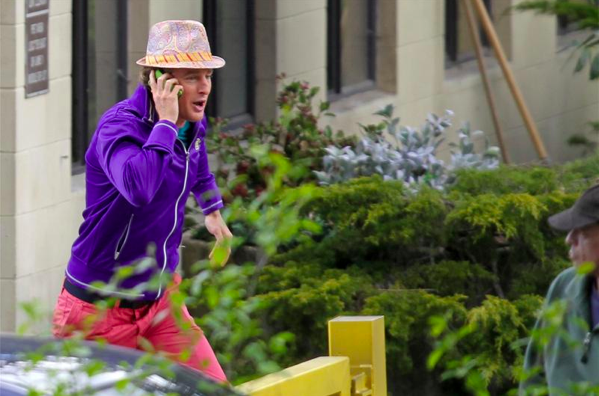
I want to watch birds with him for several reasons. Number one, he's Owen Wilson (known by some as the Butterscotch Stallion) and my hormones demand it that I be somewhere in his vicinity. Number two, I love most of his movies--Royal Tennenbaums, Zoolander, anything with Jackie Chan (if I could have an Owen Wilson/Jackie Chan sandwich, I'd die a happy woman...did I just share too much...) Number three, I WISH more birders dressed like this. Hot pink pants? Purple jacket? Turquois shirt? I have that exact hat only mine is in leopard print.
For My Mom
Hey, mom, Mr. Neil and I got a mention in the City Pages about our bees winning the blue ribbon win at the county fair for the third year in a row. Though we get the mention, I'm not fooling myself. It's our bees and dear, sweet wonderful Fabulous Lorraine who harvests it who should really get the credit.
Nightjars of the World
Best bird book of the year! I get sent a lot of books in hopes that I'll write them up in the blog or in one of the publications that accepts my articles. I've slowed down on some of it. I'm interested in certain bird books--definitely not all. For example, I do not want to ready My Aviary of Hope about some woman who goes out to find herself but finds her wings instead (really, publishers, when I say "no thank you" sending me a galley copy, a pre sale copy and a final copy will not get me to read it). That's not my kind of book--not that there's anything wrong with that, that's just not what I want to read.
I usually want the books that publishers don't know how to market. As a matter of fact, the publicist sent the list that included this book with a note that read, "Yeah, these are weird titles but on the off chance any of you want them, here they are." One of the titles practically made me salivate. And last week, Non Birding Bill found it in our PO Box and sent me the photo:
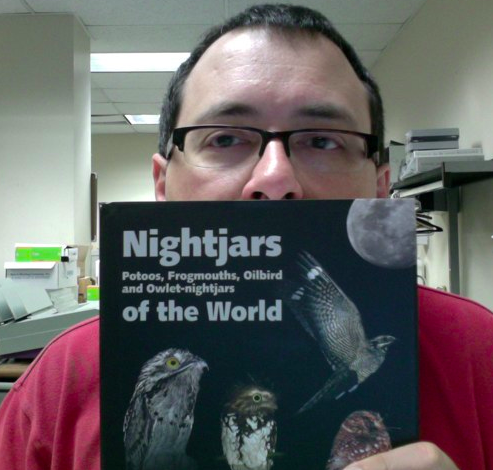
Princeton University Press has made the best bird book I've seen all year with Nightjars, Potoos, Frogmouths, Oilbird and Owlet-nightjars of the World...or more succinctly: Nightjars of the World by Nigel Cleere. It is an AWESOME book. Now, before some of you glance at that cover and say, "Ah, Shaz is geeking out over a brown bird book, time to go to the next blog," let me hit you with some of the pages of this cool tome.
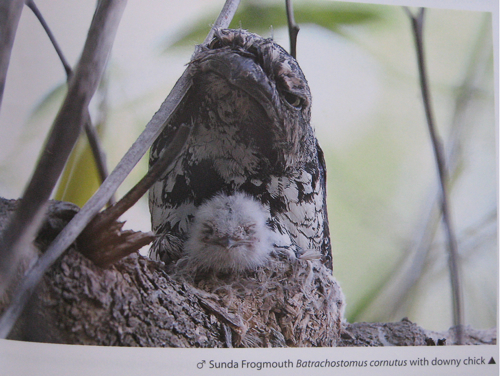
Though brown, many of these birds look like Muppets. Look at the above Sunda frogmouth (and it's little fluffy chick) from the book. Don't you half expect it to break into Manah Manah at any moment? For those who may not be familiar with this group of birds, it includes common nighthawks, whip-poor-wills or the great potoo that I saw in Panama this past February. Birds that for the most part have highly cryptic plumage and look like broken branches in trees or blend seamlessly into leaf litter on the floor.

This book is a comprehensive photographic guide (check out the crazy variations these birds come in), but also gives information about this poorly understood group of birds in an easy to read fashion. You find yourself with questions that you didn't know you had like, "Why would a species that is nocturnal need to have bizarro wing and feather patterns to display for mating? How the heck do the females see any of that at night?"
But you're also left with some interesting factoids like:
The common poorwill is the only bird to hibernate in parts of its range.
Oilbirds got their name because people used to boil down the chicks and use the oil for cooking or for lamps.
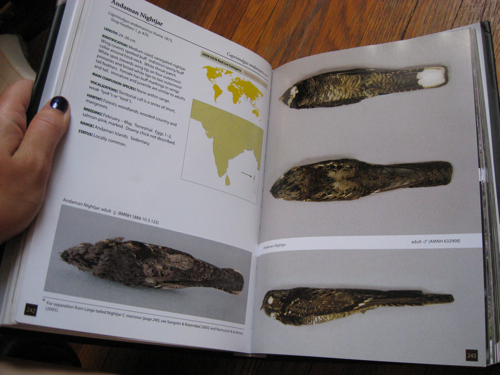
The book also strikes a chord as you realize that for some species--there are no photos of the bird in the wild, only study skins in museums. You'll also be struck by how much we don't know about the birds and how often you'll see the word "presumably" describing nesting or mating behavior.
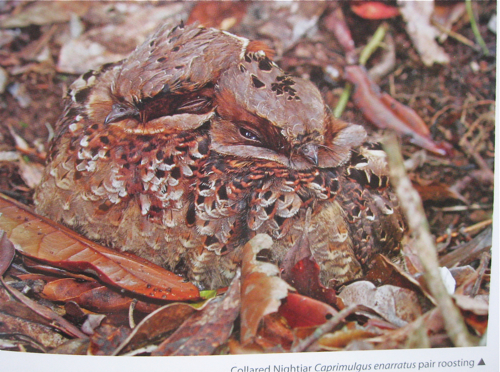
I love everything about this book and this is a trend in books that I first saw with The Shorebird Guide a few years ago and I'm happy to see it continue. We have so many photographers out there as a huge resource so you get to see the birds in different angles and the author is wise enough to write the book in an approachable way, not like a boring lecturer at a stuffy university. This book will appeal to hardcore and intermediate birders alike because this is a fascinating family of birds to study and the photos are incredible--note the snuggling collared nightjars above. Many of us will not get a chance to see most of these birds in the wild and if we do, most likely the bird will be flying away as we just flushed it. For others, this book will be an inspiration to create studies and graduate projects when you realize how much is undocumented for certain species. It's a sort of undiscovered country bird-wise. And yet for many of us, it will inspire us to save money for trips to have a chance to travel to foreign places to have a chance to see this secretive group of birds.
I would even consider giving this book to kids about 9 and up who have a strong interest in birds. There are plenty of photos and again, it's in a fairly easy to read format and the text isn't presented in an overwhelming pile of pages between photos. I would have LOVED this book when I was into birds as a kid.
Thank you, Nigel, for coming out with a great bird book.
